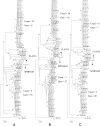DNA variation and symbiotic associations in phenotypically diverse sea urchin Strongylocentrotus intermedius
- PMID: 18852450
- PMCID: PMC2571021
- DOI: 10.1073/pnas.0807860105
DNA variation and symbiotic associations in phenotypically diverse sea urchin Strongylocentrotus intermedius
Abstract
Strongylocentrotus intermedius (A. Agassiz, 1863) is an economically important sea urchin inhabiting the northwest Pacific region of Asia. The northern Primorye (Sea of Japan) populations of S. intermedius consist of two sympatric morphological forms, "usual" (U) and "gray" (G). The two forms are significantly different in morphology and preferred bathymetric distribution, the G form prevailing in deeper-water settlements. We have analyzed the genetic composition of the S. intermedius forms using the nucleotide sequences of the mitochondrial gene encoding the cytochrome c oxidase subunit I and the nuclear gene encoding bindin to evaluate the possibility of cryptic species within S. intermedius. We have examined the presence of symbiont microorganisms by means of 16S rRNA sequences. The nucleotide sequence divergence between the morphological forms is low: 0.74% and 0.70% for cytochrome c oxidase subunit I and nuclear gene encoding bindin, respectively, which is significantly below average intrageneric sequence divergence among Strongylocentrotus species. We thus have found no genetic evidence of cryptic species within S. intermedius. Phylogenetic analysis shows that the bacteria symbionts of S. intermedius belong to the phylum Bacteroidetes, but the U and G forms predominantly harbor highly divergent bacterial lineages belonging to two different taxonomic classes, Flavobacteria and Sphingobacteria. We propose that the U and G forms of S. intermedius represent distinct ecomorphological adaptations to contrasting shallow- and deep-water marine environments and might be considered incipient species. We also propose that the symbiotic bacteria likely play an important role in the evolution of morphological divergence of S. intermedius.
Conflict of interest statement
The authors declare no conflict of interest.
Figures




References
-
- Jensen M. The Strongylocentrotidae (Echinoidea), a morphologic and systematic study. Sarsia. 1974;57:113–148.
-
- Bazhin AG. Echinoderms. In: Mooi R, Telford M, editors. Proceedings of the 9th International Echinoderm Conference; Brookfield, VT: A.A. Balkema; 1998. pp. 563–566.
-
- Kafanov AI, Pavlyuchkov VA. Ecology of the commercial sea urchins (genus Strongylocentrotus) of continental Japan Sea. Proc TINRO Center (Vladivostok) 128:349–373. (in Russian)
-
- Pudovkin AI, Serov OL, Glazko VI. Allozyme variation in four echinoids from Peter the Great bay of the Sea of Japan. Genetika. 1984;20:1139–1147. (in Russian)
-
- Manchenko GP. Genetic variability of proteins in sea urchin Strongylocentrotus intermedius. Genetika. 1985;21:763–769. (in Russian)
Publication types
MeSH terms
Substances
LinkOut - more resources
Full Text Sources
Molecular Biology Databases
Miscellaneous

